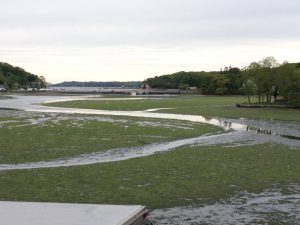A public symposium and expert workshop was held on Long Island, NY, May 17–18, 2016with the goal of developing a harmful algal bloom (HAB) action plan for Suffolk County. Three NCCOS-funded scientists along with two NOAA scientists attended the symposium and workshop, all providing expertise and suggestions for the plan.

Long Island’s coastal waters and lakes often experience HABs and hypoxia (low oxygen) due to excessive nutrients and phytoplankton production. A variety of toxic algal blooms occur around Long Island including red tides (Alexandrium), brown tides (Aureococcus), fish-killing HABs (Cochlodinium), mahogany tides (Prorocetrum), macroalga blooms (Ulva), and cyanoHABs (blue-green algae such as Microcystis). For Suffolk County, comprising more than half of Long Island and with a population of over 1.5 million, the numerous HABs threaten the health of the public and the economy.

The NOAA scientists included Quay Dortch (NCCOS ECOHAB and PCMHAB Program Manager) and, Timothy Davis (NOAA Great Lakes Environmental Research Lab). The scientists funded by NOAA included Christopher Gobler (Stony Brook University), Raphael Kudela (University of California Santa Clara), and Margaret Mulholland (Old Dominion University). Representatives of New York Sea Grant, Suffolk County, New York State Department of Environmental Conservation, EPA, the Long Island Sound Study, Stony Brook University, and The Nature Conservancy attended.
Topics covered at the two events included nutrient mitigation in Suffolk County, county water quality monitoring, the “knowns and unknowns” of Long Island HABs and their likely causes, and best management practices to limit HABs. New York Sea Grant and the Suffolk County Department of Health Services organized the symposium and workshop.
UPDATE: In September 2017, the Suffolk County HAB Action Plan was published based on the results of these meetings and expertise in the region.
For more information, contact Quay.Dortch@noaa.gov.
